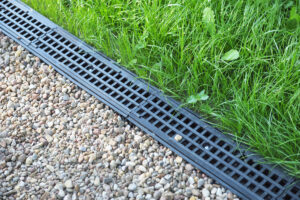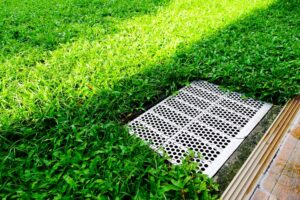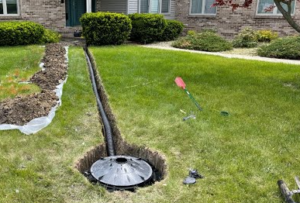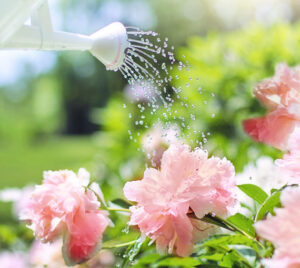PROFESSIONAL SERVICES BY
SBP Landscape & Property Services

Turfing
Turfing, also known as laying turf or installing sod, is the process of covering an area with pre-grown grass to create an instant, lush lawn. It involves the removal of existing vegetation, preparation of the soil, and the installation of pre-cultivated grass rolls or patches.

Hardscaping
Installation and maintenance of non-living elements in outdoor spaces, such as patios, decks, retaining walls, pathways, fences, and outdoor structures like pergolas or gazebos. It often involves working with materials like stone, wood, or concrete.

Sleeper Work
Use of sleepers, which are large, rectangular pieces of timber, typically used as structural elements or decorative features in outdoor spaces. Sleepers are commonly made from durable wood, such as hardwood or treated softwood, and can be used in various ways to enhance the design and functionality of a landscape.

Drainage Solutions
Planning and implementation of drainage systems to manage water flow and prevent issues like erosion, water pooling, or basement flooding. This may involve grading, French drains, rain gardens, or other techniques.

Irrigation Systems
Installation, maintenance, and repair of irrigation systems to ensure efficient watering of plants, lawns, and gardens. This can involve sprinklers, drip irrigation, timers, and monitoring systems.

Landscape Renovation
Upgrading or transforming existing landscapes by adding new features, replacing outdated elements, or redesigning certain areas to improve functionality or visual appeal.

Lawn Care and Garden Maintenance
Services related to the care and upkeep of lawns, including mowing, edging, fertilizing, aerating, and overseeding. It may also involve pest control and weed management.

Seasonal Clean-Up
Services performed at specific times of the year to prepare landscapes for changing seasons, such as leaf removal, winterization, or spring cleaning.
BEST SERVICES
By choosing turfing as a landscaping solution, homeowners, businesses, and property managers can enjoy a beautiful and functional lawn without the waiting time and uncertainty associated with growing grass from seed. Turfing provides a convenient and efficient way to achieve a vibrant and healthy lawn in a relatively short period.
Turfing, also known as laying turf or installing sod, is the process of covering an area with pre-grown grass to create an instant, lush lawn. It involves the removal of existing vegetation, preparation of the soil, and the installation of pre-cultivated grass rolls or patches.
Turfing is a popular choice for quickly establishing a new lawn or renovating an existing one. It offers several advantages over other methods, such as seeding, as it provides an immediate transformation and reduces the time required for the grass to grow and fill in.
The process of turfing typically involves the following steps:
Assessment: A thorough evaluation of the site is conducted to determine the turf variety best suited for the area. Factors such as sunlight exposure, soil type, climate, and intended use are taken into consideration.
Site Preparation: The area is prepared by removing any existing vegetation, weeds, rocks, and debris. The soil is then cultivated, tilled, and leveled to ensure a smooth and even surface. Proper soil preparation is essential for the successful establishment of the turf.
Turf Installation: The pre-grown grass rolls or patches are delivered and carefully installed on the prepared soil. Each piece of turf is placed tightly against the next, ensuring there are no gaps or overlaps. The turf is pressed firmly onto the soil to ensure good soil contact and root-to-soil bonding.
Watering and Maintenance: Immediately after installation, the turf is thoroughly watered to promote root establishment. Proper watering and maintenance practices are crucial during the initial weeks to help the roots penetrate the soil and ensure the turf’s healthy growth. This includes regular watering, mowing, fertilization, and weed control.
Turfing provides an instant transformation to outdoor spaces, creating a visually appealing and usable lawn area. It offers a range of benefits, such as erosion control, improved soil quality, reduced weed growth, and increased property value.
BEST SERVICES
Hardscaping plays a vital role in landscape design by balancing the soft elements like plants and vegetation with the harder, structural components. It adds durability, functionality, organization, and aesthetic appeal to outdoor spaces, creating an inviting and well-designed environment for various activities and enjoyment.
Here are some common examples of hardscaping elements:
Patios and Decks: These are flat, paved or raised areas designed for outdoor seating, dining, and entertainment. They can be constructed using materials like concrete, pavers, stone, or wood and are often connected to the main structure of a building.
Walkways and Pathways: Hardscaped paths made of materials like flagstone, gravel, or brick provide functional and aesthetic connections between different areas of a landscape. They enhance accessibility, guide foot traffic, and create a cohesive flow throughout the outdoor space.
Retaining Walls: These structural walls are constructed to hold back soil or create terraced areas on sloped landscapes. Retaining walls can be made from various materials such as stone, concrete blocks, or timber sleepers, and they help prevent soil erosion and create visual interest.
Fences and Gates: Hardscape elements like fences and gates serve as boundary markers, privacy screens, or security features. They can be made of materials such as wood, metal, vinyl, or composite materials, providing both functionality and aesthetic appeal.
Outdoor Structures: Hardscaping can include the construction of outdoor structures like pergolas, arbors, gazebos, and trellises. These features provide shade, vertical interest, and support for climbing plants, creating focal points and adding architectural elements to the landscape.
Water Features: Hardscape elements can be used to incorporate water features such as fountains, ponds, or waterfalls into a landscape. These elements add tranquility, visual interest, and the soothing sound of water to outdoor environments.
Fire Features: Hardscaping can include the installation of fire pits, fireplaces, or fire bowls, creating cozy gathering spots and extending the usability of outdoor spaces into cooler seasons.
Outdoor Kitchens and Barbecue Areas: Hardscape elements can be used to create fully functional outdoor kitchens or designated areas for barbecues and cooking. These spaces often include countertops, built-in grills, sinks, and storage areas, providing convenience for outdoor cooking and entertaining.
BEST SERVICES
It's important to note that the use of railway sleepers in landscaping may vary depending on local regulations and environmental considerations. Some regions have specific guidelines in place due to potential concerns about the chemicals or treatments used in preserving the sleepers for railroad use.
In landscaping, railway sleepers can be employed in several ways:
Retaining Walls: Railway sleepers can be stacked horizontally or vertically to create sturdy and visually appealing retaining walls. These walls are commonly used to retain soil, create raised garden beds, or level out sloped areas.
Steps and Stairs: Railway sleepers can be laid horizontally or vertically to construct steps or stairs in a landscape. They offer a durable and rustic option for traversing uneven terrain or creating transitions between different levels.
Garden Edging: Railway sleepers can be used as edging materials to define the borders of garden beds, paths, or driveways. Their substantial size and natural appearance create a distinct and robust boundary.
Raised Beds and Planters: By stacking railway sleepers, you can construct raised garden beds or planters. These structures provide defined spaces for planting and gardening while adding an attractive aesthetic to the landscape.
Decorative Features: Railway sleepers can be repurposed as decorative elements in landscaping designs. They can be used as seating benches, garden borders, or to create unique focal points within the outdoor space.
- Drainage solutions
- Lawn care and garden maintenance
- Landscape Renovation

Drainage solutions in landscaping refer to techniques and systems implemented to manage and control the flow of water in outdoor spaces. Proper drainage is essential to prevent water pooling, soil erosion, waterlogged areas, and potential damage to structures, plants, and hardscape elements. Drainage solutions aim to effectively redirect excess water away from the landscape, ensuring its efficient and safe dispersal.
Here are some common drainage solutions used in landscaping:
Grading: Grading involves shaping the landscape to create gentle slopes that direct water away from buildings, structures, and low-lying areas. By adjusting the contours of the land, surface runoff is guided towards appropriate drainage points, such as swales or collection basins.
Swales: Swales are shallow, vegetated channels designed to collect and transport water away from sensitive areas. They can be strategically placed to intercept and redirect surface runoff, encouraging water infiltration or channeling it towards suitable drainage outlets.
French Drains: French drains are subsurface drainage systems consisting of a perforated pipe wrapped in a permeable geotextile fabric. They are installed in trenches filled with gravel or aggregate, allowing water to enter the pipe while filtering out sediment. French drains are effective in directing and removing excess water from areas prone to water accumulation, such as soggy lawns or areas near foundations.
Dry Wells: Dry wells, also known as soakaways or infiltration pits, are underground chambers designed to collect and store excess water. They are filled with gravel or crushed stone, allowing water to slowly percolate into the surrounding soil. Dry wells help to alleviate surface water pooling and can be used in conjunction with other drainage systems.

Surface Drainage: Surface drainage solutions include catch basins, channel drains, or grates installed in paved areas or low spots to collect and channel water away. These systems effectively capture runoff and direct it into the appropriate drainage network or discharge point.
Rain Gardens: Rain gardens are shallow depressions planted with native vegetation that absorb and filter stormwater runoff. They are designed to capture and retain water temporarily, allowing it to slowly infiltrate into the soil. Rain gardens not only provide effective drainage but also help promote biodiversity and enhance the visual appeal of the landscape.
Permeable Pavement: Permeable pavement materials, such as pervious concrete or permeable pavers, allow water to infiltrate through the surface and into the underlying soil. They help to reduce runoff by enabling water absorption, which can contribute to better drainage and groundwater recharge.
It’s important to consider site-specific conditions, such as soil type, slope, and rainfall patterns, when designing and implementing drainage solutions. Consulting with a professional landscaper or drainage specialist can ensure the appropriate techniques and systems are chosen to address the specific drainage needs of your landscape.
 Lawn care and garden maintenance encompass a range of activities aimed at keeping lawns, gardens, and outdoor spaces healthy, attractive, and well-maintained. It involves regular upkeep, nurturing, and managing various elements within the landscape to promote optimal growth, aesthetics, and functionality. Here are some key aspects of lawn care and garden maintenance:
Lawn care and garden maintenance encompass a range of activities aimed at keeping lawns, gardens, and outdoor spaces healthy, attractive, and well-maintained. It involves regular upkeep, nurturing, and managing various elements within the landscape to promote optimal growth, aesthetics, and functionality. Here are some key aspects of lawn care and garden maintenance:
Mowing: Regular mowing is essential for maintaining a healthy lawn. It involves cutting the grass to an appropriate height to promote density and discourage weed growth. Mowing height and frequency may vary depending on the grass species, weather conditions, and season.
Watering: Proper watering is crucial to keep plants, lawns, and gardens adequately hydrated. It involves providing the right amount of water at the appropriate times to support plant growth and prevent drought stress. Watering methods and schedules may differ based on the specific plants, soil conditions, and climate.
Fertilizing: Applying fertilizers provides essential nutrients to plants, promoting healthy growth and vibrant foliage. Fertilizers contain a mix of nitrogen, phosphorus, and potassium, along with other micronutrients. Timing and dosage of fertilizers depend on plant requirements, soil analysis, and seasonal needs.
Weed Control: Weed management is an integral part of lawn care and garden maintenance. Regularly removing weeds and applying weed control measures, such as manual removal, herbicides, or mulching, helps prevent weed competition and keeps the landscape looking tidy.

Pruning and Trimming: Pruning involves selectively trimming branches, stems, or foliage to shape plants, promote healthy growth, and remove dead or damaged portions. Regular pruning encourages stronger plants, enhances flowering, and maintains proper form. Trimming may also include shaping hedges, shrubs, or topiaries to desired designs.
Pest and Disease Management: Monitoring for pests, insects, and diseases is essential in maintaining plant health. Prompt identification and appropriate treatment, such as organic or chemical controls, can help prevent damage and preserve the vitality of the landscape.
Mulching: Applying mulch around plants and garden beds helps conserve soil moisture, suppress weed growth, regulate soil temperature, and enhance the overall appearance of the landscape. Organic materials like wood chips, straw, or compost can be used as mulch.
Seasonal Cleanup: Regular seasonal cleanup involves removing fallen leaves, debris, and other clutter from the lawn and garden. It helps maintain cleanliness, prevents pest infestations, and prepares the landscape for the next season’s growth.
Irrigation System Maintenance: If an irrigation system is in place, regular inspection, adjustment, and maintenance of sprinklers, valves, and pipes are necessary to ensure efficient water distribution and prevent leaks or malfunctions.

Overall, lawn care and garden maintenance involve a combination of regular tasks, ongoing observation, and proactive measures to create and sustain healthy, visually appealing, and functional outdoor spaces. It requires knowledge of plant care, landscape management, and an understanding of the specific needs and characteristics of the plants and environment in question.
Landscape renovation refers to the process of making significant changes or improvements to an existing landscape design. It involves reimagining and transforming outdoor spaces by updating or modifying various elements to enhance functionality, aesthetics, and overall appeal. Landscape renovation can range from minor updates to a complete overhaul of the existing landscape, depending on the goals and scope of the project.
Here are some common aspects of landscape renovation:
Redesigning Layout: Landscape renovation often involves reevaluating and redesigning the layout of the outdoor space. This may include adjusting the placement of walkways, patios, seating areas, and garden beds to optimize flow, create focal points, or improve functionality.
Planting and Garden Enhancements: Upgrading the plantings and garden beds is a significant component of landscape renovation. This may involve removing or replacing existing plants, introducing new varieties, and reimagining the overall plant palette to achieve a desired aesthetic or address specific needs such as low-maintenance or drought-tolerant options.
Hardscape Updates: Modifying or adding hardscape elements can greatly impact the overall look and functionality of a landscape. This may include renovating or expanding existing patios, decks, or pathways, installing new features like retaining walls, water features, or outdoor structures, or upgrading materials to enhance durability and visual appeal.
Lighting Enhancements: Updating or installing landscape lighting can transform the atmosphere of an outdoor space. Landscape renovation may involve incorporating new lighting fixtures, such as path lights, spotlights, or accent lighting, to highlight architectural features, plants, or create an inviting ambiance.
Water Management: Landscape renovation may involve addressing water management issues through the installation or modification of drainage systems, rainwater harvesting solutions, or the creation of rain gardens to improve water efficiency, prevent erosion, and promote sustainability.
Outdoor Living Spaces: Upgrading outdoor living areas is a common goal in landscape renovation. This can include expanding or renovating existing patios or decks, adding seating areas, outdoor kitchens, fire pits, or creating cozy gathering spaces for entertainment and relaxation.
Sustainability and Eco-friendly Practices: Landscape renovation offers an opportunity to incorporate sustainable and eco-friendly practices. This may involve introducing native plants, incorporating drought-tolerant landscaping, installing energy-efficient lighting, or integrating environmentally conscious irrigation systems.
Landscape renovation projects can be tailored to meet specific needs and preferences, whether it’s revitalizing outdated or neglected landscapes, adapting to changing lifestyles, or incorporating new design trends. Working with a professional landscape designer or contractor can help ensure a successful renovation by providing expertise, creative input, and project management throughout the process.

